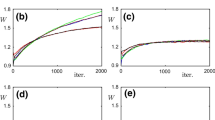Abstract
Forecasting the behavior of naturally occurring phenomena by the analysis of time series based data is the basis of scientific experimental design. In this paper, we consider a novel application of a Polychronous Spiking Network for the prediction of sunspot and auroral electrojet index by exploiting the inherent temporal capabilities of this spiking neural model. The performance of this network is benchmarked against two “traditional”, rateencoded, neural networks; a Multi-Layer Perceptron network and a Functional Link Neural Network. The results indicate that the inherent temporal characteristics of the Polychronous Spiking Network make it extremely well suited to the processing of time series based data.
Access this chapter
Tax calculation will be finalised at checkout
Purchases are for personal use only
Preview
Unable to display preview. Download preview PDF.
Similar content being viewed by others
References
Makhoul, J.: Linear prediction: A tutorial review. Proceedings of the IEEE 63(4), 561–580 (1975)
Conner, J., Atlas, L.: Recurrent neural networks and time series prediction. In: IEEE International Joint Conference on Neural Networks, New York, USA, pp. I 301- I 306 (1991)
Rape, R., Fefer, D., Drnovsek, J.: Time series prediction with neural networks: a case of two examples. In: IEEE Instrumentation and Measurement Technology Conference, Hammamatsu, Shizuoka, Japan, May 10-12, pp. 145–148 (1994)
Singh, S.: Fuzzy Nearest Neighbour Method for Time-Series Forecasting. In: Proc. 6th European Congress on Intelligent Techniques and Soft Computing (EUFIT 1998), pp. 1901–1905 (1998)
Tokinga, S., Moriyasu, H., Miyazaki, A., Shimazu, N.,, N.: A forecasting method for time series with fractal geometry and its application. Electronic and Communications in Japan, part 3, 82(3), 31–39 (1999)
Draye, J.S., Pavisic, D.A., Cheron, G.A., Libert, G.A.: Dynamic recurrent neural networks: a dynamic analysis. IEEE Transactions on Systems, Man, and Cybernetics-Part B 26(5), 692–706 (1996)
Hodgkin, A., Huxley, A.: A quantitative description of membrane current and its application to conduction and excitation in nerve. J. Physiol. 117, 500–544 (1952)
Abeles, M.: Corticonics: Neural circuits of the cerebral cortex. Cambridge University Press, New-York (1991)
Maass, W.: Networks of Spiking Neurons: The Third Generation of Neural Network Models. Neural Networks 10(9), 1659–1671 (1997)
Maass, W., Bishop, C.M.: Pulsed Neural Networks. MIT press (1998) ISBN 0-262-13350-4
Izhikevich, E.M.: Simple model of spiking neurons. IEEE Transactions on Neural Networks 14(6), 1569–1572 (2003)
Legenstein, R., Naeger, C., Maass, W.: What can a Neuron Learn with Spike-Timing-Dependent-Plasticty. Journal of Neural Computation 17(11), 2337–2382 (2005)
Nessler, B., Pfeiffer, M., Maass, W.: STDP enables spiking neurons to detect hidden causes of their inputs. In: Proc. of NIPS 2009: Advances in Neural Information Processing Systems, vol. 22, pp. 1357–1365. MIT Press (2010)
Levy, W.B., Steward, O.: Temporal contiguity requirements for long-term associative potentiation/depression in the hippocampus. Neuroscience 8(4), 791–797 (1983)
Markram, H., Lübke, J., Frotscher, M., Sakmann, B.: Regulation of synaptic efficacy by coincidence of postsynaptic APs and EPSPs. Science 275(5297), 5–213 (1997)
Izhikevich, E.M.: Polychronization: Computation with Spikes. Journal of Neural Computation 18(2), 245–282 (2006)
Arthur, J.V., Boahen, K.A.: Synchrony in Silicon: The Gamma Rhythm. IEEE Transactions on Neural Networks 18(6) (2007)
Edelman, G.M.: Neural Darwinism: Theory if Neuronal Group Selection. Basic Books, New York (1987)
Huang, C., Loh, C.: Nonlinear Identification of Dynamic Systems Using Neural Networks. Computer-Aided Civil and Infrastructure Engineering 16, 28–41 (2001)
Author information
Authors and Affiliations
Editor information
Editors and Affiliations
Rights and permissions
Copyright information
© 2014 Springer International Publishing Switzerland
About this paper
Cite this paper
Reid, D., Hussain, A.J., Tawfik, H., Ghazali, R. (2014). Prediction of Physical Time Series Using Spiking Neural Networks. In: Huang, DS., Jo, KH., Wang, L. (eds) Intelligent Computing Methodologies. ICIC 2014. Lecture Notes in Computer Science(), vol 8589. Springer, Cham. https://doi.org/10.1007/978-3-319-09339-0_82
Download citation
DOI: https://doi.org/10.1007/978-3-319-09339-0_82
Publisher Name: Springer, Cham
Print ISBN: 978-3-319-09338-3
Online ISBN: 978-3-319-09339-0
eBook Packages: Computer ScienceComputer Science (R0)




